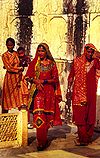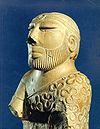
Dupatta
Encyclopedia

Pakistan
Pakistan , officially the Islamic Republic of Pakistan is a sovereign state in South Asia. It has a coastline along the Arabian Sea and the Gulf of Oman in the south and is bordered by Afghanistan and Iran in the west, India in the east and China in the far northeast. In the north, Tajikistan...
), orni/odhni, chunri, chunni, orna, and pacheri, is a long, multi-purpose scarf
Scarf
A scarf is a piece of fabric worn around the neck, or near the head or around the waist for warmth, cleanliness, fashion or for religious reasons. They can come in a variety of different colours.-History:...
that is essential to many South Asian women's suits and matches the woman's garments. Some "dupatta suits" include the shalwar kameez
Shalwar kameez
Shalwar kameez — or salwar kameez or shalwar qameez — is a traditional dress worn by both women and men in South Asia and Central Asia. Shalwar or salwar are loose pajama-like trousers. The legs are wide at the top, and narrow at the ankle. The kameez is a long shirt or tunic...
and the kurta
Kurta
A kurta is a traditional item of clothing worn in Afghanistan, Pakistan , Nepal, India, Bangladesh, and Sri Lanka. It is a loose shirt falling either just above or somewhere below the knees of the wearer, and is worn by both men and women...
. The dupatta is also worn over the South Asian outfits of choli
Choli
A choli , is a midriff-baring blouse shell garment in the Indian sari costume worn in India, southern Nepal, Pakistan, Sri Lanka, Bangladesh, and other countries where the sari is worn. The choli is cut to fit tightly to the body and has short sleeves and a low neck...
or gharara
Gharara
A gharara or bara paincha is a traditional Lucknowi garment, worn by women in the Indian Subcontinent. It consists of a kurti , a dupatta , and most importantly, a pair of wide-legged pants, ruched at the knee so they flare out dramatically...
. The dupatta has long been a symbol of modesty in South Asia
South Asia
South Asia, also known as Southern Asia, is the southern region of the Asian continent, which comprises the sub-Himalayan countries and, for some authorities , also includes the adjoining countries to the west and the east...
n dress.
History and origin
The origin of the dupatta can be traced to the Mohenjo-daroMohenjo-daro
Mohenjo-daro is an archeological site situated in what is now the province of Sindh, Pakistan. Built around 2600 BC, it was one of the largest settlements of the ancient Indus Valley Civilization, and one of the world's earliest major urban settlements, existing at the same time as the...
civilization of the Indus Basin located in modern-day Pakistan
Pakistan
Pakistan , officially the Islamic Republic of Pakistan is a sovereign state in South Asia. It has a coastline along the Arabian Sea and the Gulf of Oman in the south and is bordered by Afghanistan and Iran in the west, India in the east and China in the far northeast. In the north, Tajikistan...
, where the use of textiles such as Ajrak
Ajrak
]Ajrak is a name given to a unique form of blockprinted shawls and tiles found in Sindh, Pakistan. Ajraks are also worn by the Seraiki people of Southern Punjab and Kutch. These shawls display special designs and patterns made using block printing by stamps. Common colours used while making these...
was highly prevalent. A sculpture of the Priest King of Harrapa, whose left shoulder is covered with some kind of a chaddar, suggests that the use of the dupatta dates back to the early Indus Valley Civilization
Indus Valley Civilization
The Indus Valley Civilization was a Bronze Age civilization that was located in the northwestern region of the Indian subcontinent, consisting of what is now mainly modern-day Pakistan and northwest India...
. From here it spread across the Indian subcontinent, especially during the rule of the Muslim Mughal Empire
Mughal Empire
The Mughal Empire , or Mogul Empire in traditional English usage, was an imperial power from the Indian Subcontinent. The Mughal emperors were descendants of the Timurids...
.

Use
A dupatta is traditionally worn across both shoulders. However, the dupatta can also be worn like a cape around the entire torso. The material for the dupatta varies according to the suit: cotton, Georgette, silk, chiffon, and more.There are various modes of wearing an unsewn dupatta. When not draped over the head in the traditional style, it is usually worn with the middle portion of the dupatta resting on the chest like a garland with both ends thrown over each respective shoulder. When the dupatta is worn along with the salwar-kameez it is casually allowed to flow down the front and back.
The primary use of a dupatta is to cover the head and/or any inadvertent cleavage and the contour of the bosom. However, the use of the dupatta has undergone a metamorphosis over time. In current fashions, the dupatta is frequently draped over one shoulder, and even over just the arms. Another recent trend is the short dupatta, which is more a scarf or a stole, often worn with kurtas and Indo-Western clothing. Essentially, the dupatta is often treated as an accessory in current urban fashion.
External links
- "Indian Dupatta From Behind the Veil" An article about the dupatta

